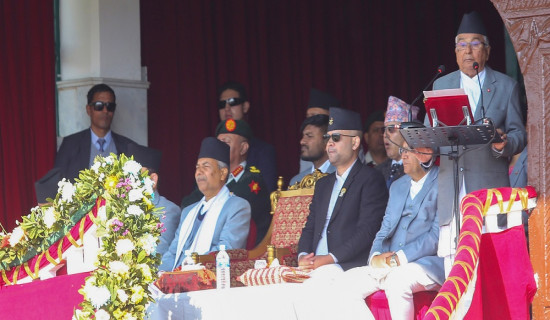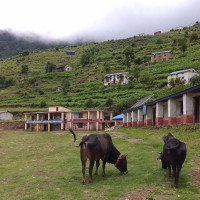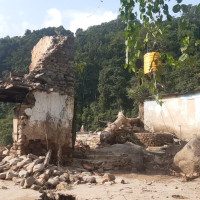- Monday, 15 December 2025
Profiteering Erodes Journalistic Credibility
Proliferation of digital media outlets in the preceding decades initially sounded a death knell to traditional journalism which offered news and commentaries through print as well as electronic mediums like radio and television. But contrary to such gloomy predictions, conventional journalism has survived and continues to retain its impactful presence worldwide. The omnipresent digital media has not been able to replace the ‘legacy media’ in its entirety despite Elon Musk’s wish and pressures via his advocacy in social media.
The existing media landscapes in the US, UK and the rest of the West depicts the present-day reality: newspapers ranging from the New York Times, Washington Post and Wall Street Journal to The Times and The Guardian are a few examples of how the print medium continues to reach readers, though a larger section of them now prefer to read the news through their online editions. Similarly, radio and television networks are also doing their job, even though their audiences like those of newspapers, have switched to alternative tools—the ubiquitous smartphones, which come in varying shapes and appearances.
The changes seen thus far have proved that all that the improvised information technology has add one more platform, the digital in line with the evolving media environment. Usable contents have always been generated to meet the prevailing requirements—and tastes.
Global context
If one were to examine this issue in a global context, one learns that when radio broadcasting began as a source of news and information in 1920, some people feared that newspapers would fold instantaneously.
However, that did not happen. Then came the era of television broadcast, in 1936, which also was perceived as a threat to both radio and newspapers. But that too did not happen. Instead, all three mediums existed together, making themselves supplementary and complementary to each other. Now the digital version has entered the global society, essentially to make it livelier. There is nothing to be alarmed at.
Nepal’s case isn’t different from where modern-day journalism began in 1901, with the publication of a weekly Nepali language newspaper—the Gorkhapatra.
It remained the sole mass communication channel for the next half a century, up until the political upheaval of 1950. With the dawn of democracy in early 1951, Nepal swiftly entered the age of radio broadcasting via Radio Nepal. Television came into the picture in 1984.
Let’s turn to the print medium again. Weekly Gorkhapatra subsequently became a twice-a-week news sheet and then a three times a week newspaper for several years, until it was made a daily in 1961.
The royal takeover of government in late 1960 was followed by a new form of governance with changes, including those in communications. Accordingly, specific legislation aimed at transforming the publication into a full-fledged self-governing institution was enacted. A new entity, named Gorkhapatra Sansthan, equipped with a printing press, took steps to expand its outreach to all parts of the country. Meanwhile, the Sansthan decided to bring out a broadsheet daily in English. Accordingly, The Rising Nepal was launched in December 1965. Subsequently, a few more titles were added: literary Madhuparka,Yuva Manch for youths and Muna for children.
All of these publications have online editions to satisfy the appetite of the Nepali diaspora abroad. In post-1990 Nepal, democratic governments liberalised communication policies and laws to attract investments in the news media industry.
As a result, the number of media outlets, including digital sites and FM radios, rose remarkably. However, in the absence of effective mechanisms to monitor and regulate media outputs, constitutionally guaranteed freedom of speech and publication have been frequently abused. Since Nepal’s small-sized economy could not generate adequate advertising revenue for these media outlets to defray running costs, the new media operators found it expedient to accept donations from local and foreign non-governmental organisations (NGOs).
The quid pro quo would be a willingness to push forward mysterious NGO agendas, some of which could be pernicious to native cultures and religions. US President Donald Trump himself referred to alleged fraud and mismanagement when he issued an order to dismantle USAID. Trump said some of the assistance given to Nepal was used to expand ‘atheism’ in this Hindu-majority country.
National reality
Media outlets influenced by money from opaque sources have tended to resort to misinformation and disinformation campaigns, ultimately eroding the credibility of the media fraternity as a whole. The principles of fairness and accuracy are visibly compromised, and so are ethical standards universally recommended for journalists. Besides, issues related to training and orientation facilities have never been taken up seriously even by established media houses, some of which have licences to own and run newspapers, radio and television simultaneously, along with their online versions. The profiteering tendency usually applied by these media houses has deprived readers of quality journalism. Besides, armchair journalism practised by some reporters (and apparently encouraged by their editors) has left little room for freshness, fairness and authenticity.
Since most of the media outputs, especially the digital ones, have lost credibility in recent times; these are no longer considered reliable sources of public information. And no amount of fact-checking has so far assured audiences who are already overwhelmed by planted stories and ‘paid news’s’ (i.e., advertisement in the garb of regular news stories).
Incidentally, how does ChatGPT respond when someone like the present writer asks about the credibility of the media? In response to a recent query in this regard, it assessed the online media as ‘least reliable’ compared to print, radio and television—in that order. “Print media (like newspapers and magazines)”, it said, "while struggling economically, is still generally viewed as more credible because it traditionally follows stricter editorial standards.” While the traditional media avoid printing speculative and partisan news reports, the ‘new media’ do not see any harm in letting them into their news distribution system. And their ‘news managers’ hardly bother to scrutinise stories for accuracy and balance.
This being the background, which media organisation in Nepal currently stands out to have maintained comparatively better editorial standards, thereby presenting reliable journalism to the people at large? It is undoubtedly Gorkhapatra, The Rising Nepal and Sansthan’s other publications. Logically, such a recognition should have been elicited by print media run by private entrepreneurs who are better placed to enjoy press freedom guaranteed by our democratic constitution. Conversely, it is the privately owned media outlets which are steadily losing credibility and thereby audiences. And it appears difficult to see these trends being reversed any time soon.
(Adhikary is a journalist active since 1978 and writes on regional issues.)
















